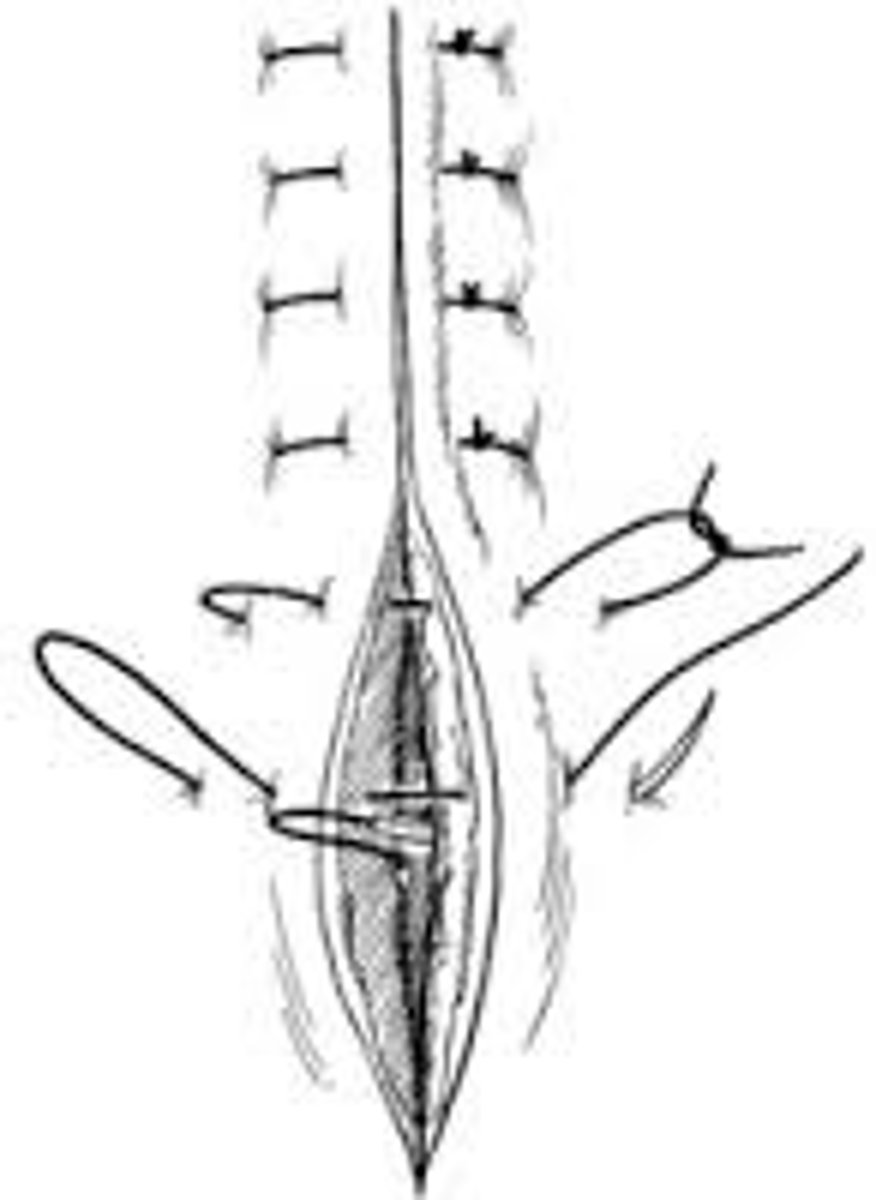clin skills II: advanced suturing
1/28
Earn XP
Description and Tags
becca_frizz
Name | Mastery | Learn | Test | Matching | Spaced |
|---|
No study sessions yet.
29 Terms
interrupted sutures
-simple
-vertical mattress
-horizontal mattress
-subcuticular
continuous sutures
-running
-running locked
-subcuticular
when is vertical mattress suture best used?
in creases and areas of natural inversion (back of hand, or other sites of loose skin)

where is the 2nd mini-suture in a vertical mattress?
-in the same line as the main suture
-needle is inserted to pick up just the skin of both wound edges
-ensures eversion of the skin edges
purpose of the horizontal mattress
-pulling wound edges together over great distances
-used as an initial suture to anchor the wound and hold the 2 wound edges together
-fragile skin
-good hemostatic suture
what should be considered with a facial laceration?
-copious irrigation should be used
-explore wounds for foreign bodies
-gross asymmetry may signify underlying nerve damage
anesthesia for facial lacerations
lidocaine with epi
suture choice for facial lacs
-nylon for skin
-chromic/vicryl for mucosal lacerations
suture placement for facial lacs
generally closer together than usual (1-2 mm from skin edges and 3 mm apart)
mucosal laceration procedure
-realign the wet-dry mucosal border
-place the fist stitch at the border between the wet and dry surfaces
-absorbable 4-0 suture
-sew wet mucosa to wet and dry to dry
-evert the edges
-tie at least 4 or 5 knots
sutures for partial thickness that crosses the vermilion border
-align the red/white marigin first. place initial suture just outside the vermillion border using 5-0/6-0 suture
-remaining sutures lip skin 5-0/6-0 and lip mucosa 4-0/5-0
sutures for full-thickness lac on lip
-repair the mucosa with absorbable 4-0 suture try to evert the edges
-irrigate the wound
-repair the muscle with 3-0/4-0 figure of eight suture in the muscle
-repair the skin
indications for repair of intraoral mucosal lacs
-mucosal laceration that creates a flap that interferes with chewing
-mucosal flap that is large enough to trap food particles
-wounds longer than 2 cm
sutures for intraoral mucosal lacs
-absorbable 4-0 suture
-2-3 mm from the edge of the wound and include only the mucosa
-evert the edges
how should the skin and subq tissue/muscle be repaired with a full-thickness cheek lacerations?
repair the skin using 5-0 nylon sutures
which tongue lacs should you consider closing?
-large lacerations (>1-2 cm)
-large gaping wounds, esp with the tongue at rest
-wounds requiring suturing for hemostasis
-anterior split tongue
sutures for tongue lac
-lidocaine with epi
-irrigate
-absorbable 3-0/5-0 sutures in a figure of eight fashion in the inner muscle
-in unable to suture the inner muscle, then take larger and deeper bites approx 4-5 mm from edge using 3-0/4-0 absorbable suture
how should full thickness nasal lacs be repaired?
-skin-plain lidocaine
-small 5-0 non-absorbably suture, align the alar rim
eye lid lacerations sutures
-don't repair full thickness
-place a small 6-0 suture to reapproximate the gray line
-close skin loosely with 5-0 or 6-0 suture
what should you do before repairing a ear lac?
inspect the TM and external auditory canal and facial nerve
scalp laceration repair
-lidocaine with epi (when possible)
-suture the aponeurosis layer with 3-0 or 4-0 vicryl (simple or figure of eight)
-close the skin with a continuous locking suture 3-0 nylon or Vicryl, or skin stapler
indications for nerve blocks
-when local anesthesia at the site of the incision may not be effective
-when edema from the local injections would distort anatomy landmarks
-when edema from the local injection would make it difficult to palpate deep tissue to be excised
-when repairs/excisions are quite large and prohibit the use of large amounts of anesthetic
contraindications for nerve blocks
-need to inject through infected tissue
-presence of septicemia
-allergy to medication
nerve block procedure
-neurologic exam and document results
-identify the nerve area
-obtain informed consent
-clean site in sterile fashion
-draw up medication
-inject-aspirate
-allow 5-15 minutes before procedure
mental nerve block
-innervated the lower lip and skin below the lip
-the nerve exits the mandible just inferior to the second mandibular bicuspid midway between the upper and lower edges of the mandible approx 2.5 cm from the midline of the jaw
-needle is introduced at the gingival buccal margin aspirate and inject 2 ml
what does the buccal nerve block anesthetize?
the mucous membrane of the cheek and vestibule and, to a lesser extent, a small patch of skin on the face
when is an infraorbital nerve block?
used to repair upper lip laceration and lacerations of the lower lateral nose and eye lid
technique for infraorbital nerve block
-direct infiltration through the skin over the area
-intraoral technique: introduce needle at gingival buccal margin over the maxillary canine and inject approx 2 ml at the infraorbital foramen
what does the lingual nerve block anesthetize?
the anterior two thirds of tongue